Day 1 – Saturday – Lima – Arrival
Arrival in Lima, the "City of Kings" famous for its Spanish Colonial architecture, extraordinary museums and cuisine. Lima is internationally recognized as the "Gastronomic Capital of the Americas", and its cuisine is considered among the most diverse and exquisite in the world on par with French cuisine. Upon arrival a host will meet and assist you in transferring to the hotel and in registering.
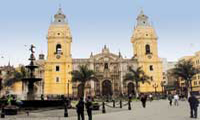
Day 2 – Sunday – Lima – City Tour (B,L,D)
Tour of Modern and Colonial Lima - This half-day tour visits both the colonial and modern sections of Lima. Colonial sites include the lovely Plaza Mayor, the Government Palace, San Francisco Church and the exquisite Torre Tagle Palace modern day seat of the Ministry of Foreign Affairs. In modern Lima, drive along the exclusive residential areas of Miraflores and San Isidro.
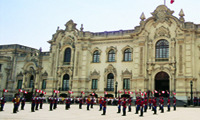
Lunch at La Rosa Nautica
Please your palate and soothe your soul at this delightful restaurant just above the Pacific waves, and enjoy its privileged location with stunning views. La Rosa Nautica offers a diverse and unique cuisine. The renowned Peruvian chef Enrique Blondet with a group of professionals in gastronomy have created a great selection of Peruvian and International specialties.
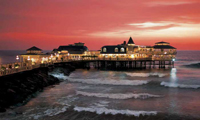
Dinner and Folkloric Show at Junius
Junius Restaurant takes you to a journey to explore the wonders of the fascinating Peruvian culture through its folklore, presenting an incredible and colorful show of music and dances from different regions of Peru. The delicious buffet is full of flavors from different regions and the best of the Peruvian cuisine.
Day 3 – Monday – Lima – Cusco – Sacred Valley (B,L)
Early morning transfer from the hotel to the airport for a short but spectacular flight over the snowcapped Andes to the oldest inhabited city in the hemisphere, Cusco, at an elevation of 11,440 feet.
Upon arrival a host will meet and assist you in transferring to the hotel and in registering.
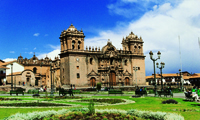
Visit to Awana Kancha
This Living Museum of the Andes showcase the South American Camelidos such as llamas, vicuñas, guanacos and alpacas in their native environment. You will also enjoy a spinning and weaving demonstration of ancient techniques on how to make clothing from the wool fibers of these animals. You can also see native flowers and some agricultural terraces from the Inca times.
Lunch at Wayra with Peruvian Paso Horse Show
“Caballo de Paso” known worldwide for their smooth gaited movements and unusual spirit. No other horse combines strength, intelligence and beauty so perfectly as the Peruvian Paso Horse. The particular characteristic of the Paso Horse is precisely the reason for its name: the sublime charm of its typical step. As it walks, its front legs step very high and forward while the hooves sway to the sides in a graceful and synchronized movement. Enjoy a delightful demonstration of the skills of this unique member of the horse kingdom. Lunch at the celebrated Wayra at “Sol y Luna” in the Sacred Valley.
Day 4 – Tuesday – Pisac Market and Ollantaytambo Archaeological Complex (B,L)
Full Day Excursion to the Pisac Indian Market and the Ollantaytambo Fortress - Morning departure for a drive through the fertile countryside of the Urubamba Valley to the colonial village of Pisac where an Indian Market takes place Tuesdays, Thursdays and Sundays. Other days you will tour the religious nucleus and archaeological site of Pisac. During your visit to the bustling marketplace you will have the opportunity to bargain with the natives for many different types of Peruvian handicrafts and jewelry.
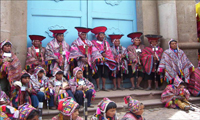
Continue to the Ollantaytambo archaeological complex, the Incas built it as a fort that included a temple, agricultural terraces, and an urban area. There are two distinct sectors: The religious and worship zone, and the residential area. Ollantaytambo was an important administrative center with probable military functions if one considers the walls and towers. There are also traces of ancient roads and aqueducts. The town of Ollantaytambo is called a "Living Inca Town" since the inhabitants maintain very old practices and customs.
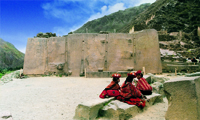
Lunch is served at Hacienda Huayoccari
–The most noticeable aspect of the house is its sensational setting, dominating the Urubamba valley in the midst of the highland crags and vegetation through which the river flows. Above it, on the very mountain top within sight of heaven are two lakes, which seem to seethe on a rainy night. With magnificent views of the Urubamba River, the Casa-Hacienda has the magical ability to make us forget the reality of life. Today’s lunch will be a remarkable event.

Day 5 – Wednesday – Moray, Maras and Seminario Ceramic Workshop (B,L)
Moray, Maras Salt Pools and Seminario Ceramic Workshop – Pass through unspoiled and picturesque Andean communities on your way to the Incan agricultural experimental center of Moray, famous for its sunken amphitheater, made up of four circular terraces, which appear to fade away into the earth like an artificial crater. The site was apparently an Inca agricultural research station filled with fertile earth and watered by complex irrigation systems, designed for experimenting with crops at various altitudes.
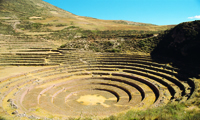
Continue to the impressive Maras salt pools formed by water emerging from a lake inside a mountain in the Urubamba Valley. An amazing view of evaporating ponds for the extraction of salt. Learn about ancestral techniques, which are still used, in agricultural, irrigation and salt-recollection tasks, as well as in Andean festivals and rites. Lunch is at Parador in Moray.

Ceramic Workshop with Pablo Seminario
Pablo Seminario Ceramic Studio has been dedicated to the discovery of techniques and designs from ancient Peruvian cultures. Pablo presents a new art expression, providing continuity to these cultural inheritances. He concentrates on making large-format works of art, "great plates", as he calls them, at his personal workshop. The images that emerge here are the result of the patient work of following the tradition of pre-Colombian pottery, an ambitious task which got underway 20 years ago and which he continues to develop.
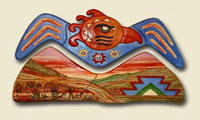
Day 6 – Thursday – Machu Picchu excursion aboard the Orient Express Luxury Train “Hiram Bingham” (B,L,D)
Morning train ride aboard the most luxurious railway service in South America to enjoy the unbelievable sights of the "Lost City of the Incas," Machu Picchu. Perched 8,200 feet above the valley, it was hidden by mountains and semi-tropical jungles for 400 years until discovered by Hiram Bingham of Yale University in 1911.
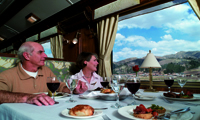
Archaeologists believe that the Inca "Virgins of the Sun" took refuge from the Spanish Conquistadors here. Guided tour of the Sanctuary and plenty of free time to study the mysterious site.
Brunch and four-course dinner and cocktails are aboard the Hiram Bingham.
Afternoon “Tea Time Goodies” at the Orient Express Sanctuary Lodge, located just a few steps from the Inca citadel is also included.
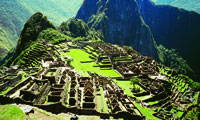
Day 7 – Friday – Huayna Picchu and the Sun Gate. (B)
Tour guide at disposal to further enjoy one of the most incredible sights on earth, the sanctuary of Machu Picchu. Take as much time as you need to study these magnificent ruins, hike the steep stone-paved trail of Huayna Picchu, the pyramid-shape mountain above Machu Picchu for a breathtaking view of the site, or stroll to the Inca Bridge a secret entrance used by the Inca's army or walk toward the Inca Trail to find the historic Intipunku or Sun Gate.
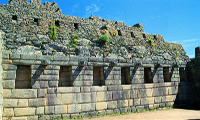
Day 8 – Saturday – Machu Picchu – Cusco (B,D)
PM return train ride to Cusco aboard the Hiram Bingham. Dinner is included.
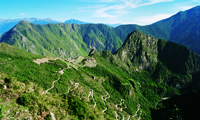
Day 9 – Sunday – Cusco City Tour and Nearby Ruins (B)
Tour of Cusco and Nearby Ruins – Visitors are caught up in the excitement of touring the ancient capital of the Inca Empire, a delightful combination of Inca and colonial architecture. The tour visits important landmarks such us Cusco's Cathedral, Plaza de Armas and Koricancha “The Temple of the Sun”. This tour of the oldest continuously inhabited city in the western hemisphere also includes the nearby ruins of Kenko, Puca-Pucara, Tambomachay as well as the Sacsayhuaman fortress, an imposing example of Inca military architecture.
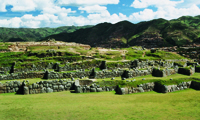
Day 10 – Monday – Cusco – Puno (B)
Early morning transfer from the hotel to the airport for your flight to Puno. Upon arrival a host will meet and assist you in transferring to the hotel and in registering.
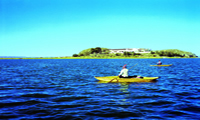
Day 11 – Tuesday – Puno – Suasi Island on Lake Titikaka (B,L,D)
Boat excursion to Uros and Taquile Islands on Lake Titikaka. This full day excursion will take you to the highest navigable lake in the world to the floating islands of the Uros Indians, man-made islands by tying totora reeds. The Uros considered themselves Lords of the Lake; they hunt wild birds and maintain traditional fishing methods. The men have developed an extraordinary skill in weaving reeds; producing houses, boats and handicrafts, and the women are expert knitters.
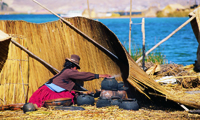
Continuing to Taquile Island where a native community of about 400 families still lives with the traditions and high principals of the Incas. Taquile is a very important site on Lake Titikaka for its archeological remains, the sacred and ceremonial sites, the festive activities and their rituals. Taquile is characterized by its friendly inhabitants, who maintain their customs and traditional clothing. They distinguish themselves by their detailed, fine, and colorful textiles with symmetrical decorations and symbols that reflect their way of life and Andean beliefs. Continue to Suasi Island. Lunch and dinner are included.
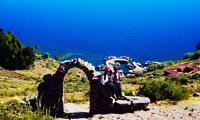
Day 12 – Wednesday – Suasi Island – Puno (B,L,D)
Martha’s Cultural Cabin is one of most interesting activities in Suasi Island. Martha Giraldo, the owner of the island, runs a cultural cabin where our travelers can meet the Altiplano and Lake Titicaca ecosystem singularity, standing out human participation along the history of livestock breeding, agriculture, ceramics and textiles. The cabin counts with one of the most complete libraries with books about the Altiplano.
Lunch and dinner are included.
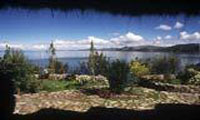
Other activities available are trekking along trails within Suasi Island, visiting protected areas to observe flora and fauna, visiting Andean farming plots and cultivated parcels with aromatic and medicinal herbs, canoe rides around the island and walking along the beach.
Return to Puno.
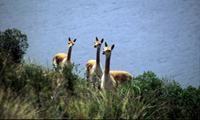
Day 13 – Thursday – Puno – Sillustani Burial Towers on route – Arequipa (B)
Excursion to Sillustani Burial Towers on route. This complex stands on the shore of Lake Umayo and is famous for its chullpas, large circular fortified burial towers for the chiefs and important people of the early villages of the Collao plateau. Some are 12 meters high (39 feet), and remarkable for their shape, thinner at the base and wider at the top. These ancient and impressive tombs from the pre-Inca period were built from a mixture of stone and adobe.
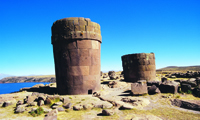
Transfer to the airport for your flight to Arequipa at an elevation of 7,300 feet. Upon arrival a host will meet and assist you in transferring to the hotel and in registering.
Also known as the "White City" for its many constructions built of white volcanic stone, Arequipa is at the foothills of the Misti Volcano (the guardian of the city) and it has a splendid Cathedral that is considered one of the first seventeenth century religious monuments of the city.
Day 14 – Friday – Arequipa City Tour and Santa Catalina Convent (B,L,D)
- Your half day sightseeing of this beautiful city, placed on the World Cultural Heritage list by UNESCO, features Mixed Baroque churches and mansions from the colonial period like the Monastery of Santa Catalina, The Main Square is bordered by various arched walkways and the Cathedral, it showcase a beautiful bronze fountain of three plates crowned by the figure of a sixteenth century soldier. Around the square, you see three granite portals with brick and lime bases.
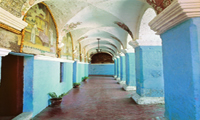
The Santa Catalina Convent is called "a city within a city", a Spanish city in miniature with stone streets, beautiful patios, and plaza, it is a masterpiece of colonial architecture, and houses some of the finest examples of Spanish American religious art. Since 1970 visitors have been able to stroll through the streets and cloisters that during colonial times were the refuge of female nobility who had decided to isolate from the world and dedicate entirely to prayer.
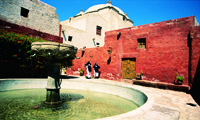
Arequipa – Colca Canyon
Departure towards the highlands passing through Yura-Pampa Cañahuas and La Pulpera with good possibility of observing groups of wild vicuñas and fighting cattle. The road to the Colca Canyon reaches a high point of 13,000 feet before dropping down to the valley, an area of breath taking landscapes surrounded by terracing and snow-capped peaks. Far below, at a depth of 10,000 feet, the Colca River winds along the bottom of the canyon, the world's deepest.
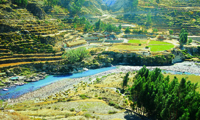
Stop en route to see petroglyphs in the Caves of Mollepunco and in the town of Callali to see natural hill formations with the appearance of enchanted castles. Continue to La Calera to enjoy the thermal baths under the stars.
Overnight in the Colca Canyon area
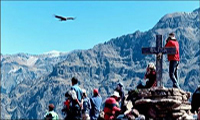
Day 15 – Saturday – Colca Canyon – Arequipa (B,L)
To maximize your probability of seeing condors we depart very early towards a superb natural lookout point “Cross of the Condor” from where one can watch condors wheeling across the Colca Canyon, at about an altitude of 15,000 feet. The valley also features pre-Inca ruins, pre-Inca burial grounds and archaeological remains left behind by the Collagua, the ancient inhabitants of the area. Drive further in to the canyon to observe the way of life in this remote land and to admire the impressive irrigation system and the fertile mountains terraced for farming of the Colca valley.

Ask your guide to take you to one of the many workshops in which close to a thousand artisans, scattered throughout the towns in the canyon, turn their ancient sewing and weaving machines into paint brushes to give life to impressively intricate and colorful embroidery and shawls.
Afternoon return to Arequipa.
Day 16 – Sunday – Arequipa – Lima – Iquitos (B)
Early morning transfer from the hotel to the airport for a short flight to Lima, which for a short period of time became the most important city in the Americas. With a UNESCO World Cultural Heritage historic center showcases splendid samples of Colonial architecture.
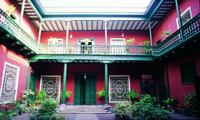
Larco Museum
Continue to the Larco Museum, founded in 1926, it displays remarkable chronological galleries providing an excellent overview on 3000 years of development of Peruvian pre-Columbian history. Located in a unique vice-royal mansion of the 18th century built over a 7th century pre-Columbian pyramid is surrounded by beautiful gardens. The Larco Museum also features the finest gold and silver collection from Ancient Peru and the famous erotic archaeological collection, one of the most visited Peruvian tourist attractions.
Late afternoon transfer to airport for flight to Iquitos.
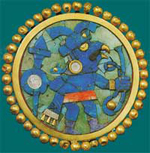
Flight to Iquitos, on the Amazon River
Flight to Iquitos on the shores of the legendary Amazon River. This region is covered by dense vegetation and by primary and secondary jungle with low hills and slightly rolling landscape, crisscrossed by the many rivers of the Amazon River basin, which is born at the confluence of the Marañon and Ucayali Rivers.
Dinner and a brief walking tour of this main port city on the Amazon River and the largest city in the Peruvian jungle.
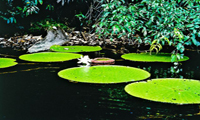
Day 17 – Monday - Iquitos – Ceiba Tops (B,L,D)
Transfer to the Explorama dock. Twenty-five mile journey down the Amazon River to Ceiba Tops where private rooms with air conditioning and hot water provide all of the comforts of home. Afternoon hike in the beautiful primary rainforest reserve surrounding Ceiba Tops which includes many huge trees festooned with epiphytes. After dinner there may be local flute or guitar music at the El Toucan Bar or the guides are always ready to relate some of the many legends of the Amazon forest.
Lunch, Dinner Overnight Ceiba Tops.
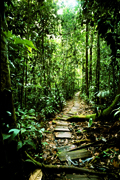
Day 18 – Tuesday – Ceiba Tops (B,L,D)
Morning boat ride, spotting for dolphins, to visit a small village of Yagua Indians where your guide will explain the Yagua Indian culture and how it was affected by the arrival of Europeans and the passing of time. There will also be an opportunity to see some of the local crafts and for a demonstration of the blowgun which some of the Yagua elders still use for hunting. Afternoon walking excursion to the neighboring town of Indiana stopping along the way to see the immense Ceiba tree for which the lodge is named. Originally a Franciscan mission, Indiana has grown into a large river community with its own market, high school and small hospital.
Lunch, Dinner Overnight Ceiba Tops.
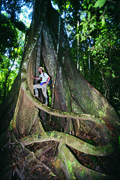
Day 19 – Wednesday - Ceiba Tops – Canopy Walkway – Ceiba Tops (B,L,D)
Early morning departure from Ceiba Tops by boat to the narrow motorcar crossing connecting the Amazon and Napo Rivers to continue by boat to ExplorNapo Lodge for breakfast. Hike to the spectacular Canopy Walkway spanning over 500 meters (one-third of a mile), connected by tree platforms, and reaching a height of over 35 meters (115 feet) but accessible without any type of climbing skill or equipment. After lunch, visit the "ReNuPeRu" Ethno botanical Garden where over 240 medicinal plants are cultivated by a local shaman who will explain the nature of Amazonian natural healing and the uses of some of the plants. Return to Ceiba Tops in time to enjoy the pool or hammocks before dinner. Breakfast, Lunch, Dinner Overnight Ceiba Tops
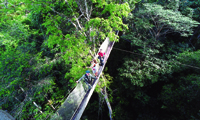
Day 20 – Thursday - Ceiba Tops – Iquitos – Lima (B)
Your choice of a morning walking or boating excursion to further enjoy the rainforest and Amazon River or time to relax by the pool until departure time. Afternoon transfer to Iquitos and to the airport.
Breakfast, Lunch (if departure flight permits)
Due to the ever-changing nature of the rainforest, day-by-day activities may vary due to local conditions.
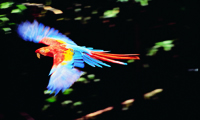
Magic Water Circuit ( From Wednesday to Sunday )
Late afternoon visit the Magic Water Circuit at Parque de la Reserva. This recently remodeled park boasts 12 beautiful water fountains that literally “dance” under an awesome choreography of music, lights and laser beams. This park is the pride of Lima and has been recognized by the Guinness Book of World Records as the largest water fountain park in the world. The 80-meter high water fountain is an impressive view.
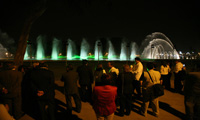
Day 21 – Friday – Lima – Home (B,L) Discover Larcomar
This fashionable shopping and entertainment center became the favorite for visitors and locals. Right in front of the Pacific Ocean, Larcomar showcases 17 restaurants and cafes with a wide variety of international and Peruvian food, the finest selection of handicrafts and art galleries, a good selection of prestigious brand stores offering products such as alpaca and llama apparels, silver and gold jewelries, exclusive discotheques and bars, ATM machines and movie theaters. Located in the heart of Miraflores, at the end of Larco Avenue and across the street of the Lima Marriott Hotel.
Lunch at Huaca Pucllana
The Huaca Pucllana Restaurant provides and an outstanding cuisine and enjoys a privileged location, it is practically on top of an ancient Inca Pyramid. In the Fifth century, the Lima valley inhabitants started the construction of the Huaca Pucllana. Under the management of sacred priests, the Huaca Pucllana was built as an expression of their religious authority and to control the hydrological resources stemmed from the water canal system, on the left bank of the Rimac river. Pucllana was an important ceremonial and administrative location. Its magnificence was reflected by the configuration of a monumental architecture.
Flight Return Home
Transfer to the airport for your departure to your international flight. Arrive home full of great memories of the rich tradition of Colonial Lima and the mystical Land of the Incas.
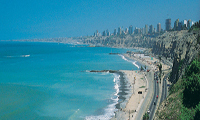
End of Services
Departures:
Daily, preferable Saturdays.
For further information please email us to. Sales4@FiestaToursPeru.com